 When someone uses the term tramping gear ‘essentials’ you probably think toilet paper and the nearest bathroom, to check that you’re wearing underwear, or they mean food and water.
When someone uses the term tramping gear ‘essentials’ you probably think toilet paper and the nearest bathroom, to check that you’re wearing underwear, or they mean food and water.
No, I won’t be talking about underwear, mainly because that can be optional and a tricky subject in the outdoors. When I say tramping gear essentials I mean more along the lines of the actual gear selection – a heavy topic indeed, but never fear, whatever your budget, activity or intention, you’re sure to get something valuable from this post where I get to geek out a little.
I say tramping because that’s what we call hiking here in New Zealand. But this list will serve you well if you are looking for hiking essentials or what to take hiking! They are the same thing!
The magic 5 tramping gear essentials I consider are;
- Sleeping mat
- Sleeping bag
- Tent
- Cooker
- Backpack
Gear selection seems to be a never-ending endeavour, however after 10 years and at least three different sets of gear people now seem to keep asking me for advice on what I choose – So perhaps I do know what I’m talking about, or am a good pretender.
A quick exclaimer – I tend to have a different set of tastes, push the envelope a little and perhaps quite enjoy a good suffer-fest (I once built a snowcave instead of sleeping in the hut simply because there was a couple of people inside and I wished for my own privacy). Know that my selection is personal and that you should experiment to satisfy your own needs.
GRAB AN EXTENSIVE TRAMPING LIST CHECKLIST FOR YOUR NEXT ADVENTURE BELOW!
The form you have selected does not exist.
Now, let’s get stuck in with this short and sweet gear list for tramping!
Tramping Gear Essentials
Sleeping Mat
The honest sleeping mat is probably the best, and the funniest unit of measurement in the outdoors when it comes to seeing how experienced a person is. The sight of a blowup lilo, or a foam mat almost brings a tear to the eye with laughter – PLEASE BURN THESE. You will thank me later. A good quality sleeping mat is perhaps the most essential to a good night’s sleep. The humble mat will complement your sleeping bag for warmth and comfort. Spend the money and get a decent one.
Have a look at the Kathmandu website if you are in New Zealand as they have a range of options. Just click the image below to be taken to their website.
Or, have a look at the following selections for comparison.
Clever Hiker- Best Sleeping Pads
Outdoor Gear Lab – Best Sleeping Pad
There are many options to choose from. If you can, I suggest going into a store and testing them out for yourself! I use the following;

Although not the most comfortable, and perhaps a little noisy (don’t use this for tent shenanigans), I picked this because it is fast and light! This is less than 500g and is the size of a 750ml water bottle!
Sleeping Bag
What complements the humble mat better? These two work together to keep you warm, comfortable and to get a good night’s sleep. The choice of an actual bag is an intense discussion and highly personal. You should consider the following;
- Season
- How hot/cold you sleep
- Elevation
- Climate
- How many clothes you take
- If you use a liner or not
- How warm your mat is
Obviously, if you’re using a winter bag in Death Valley you could sleep extremely cold, or you could enjoy sleeping in your own sweat… don’t do that. Think of where you intend to travel, what season it is, if you’re going into the alpine or not and personal preference before you select your sleep system.

I say ‘sleep system’ because what you wear to bed, the mat, the bag and a liner, all influence each other. A good merino liner can drastically increase the temperature range you can get away with.
If you’re going in winter, getting high in the mountains, or taking an adventure in the snow then you can’t really compromise – get a winter bag. Specifically, in New Zealand, a good three season bag will get you almost anywhere! If it’s too hot, de-layer, if it’s too cold, wear down and/or use a liner. If it’s really hot, sleep on top of your bag or use the liner.
Have a look at the Kathmandu website if you are in New Zealand as they have a range of options. Just click the image below to be taken to their website.
Or, for a comparison check out some of the following bags;
T3- Best lightweight sleeping bags
Wilderness Mag- Best sleeping bag
Once again, spend the money! This is an investment that you will have for a long time!
I use and recommend:
Sea To Summit Lightweight Sleeping Bags
Once again, this is light and extremely packable! This bag is good for -2 degrees. Because I sleep warm and have the option of a liner I have used this everywhere, including in Canada in -15 degrees where I wore my down, and used the liner – I do enjoy the odd bit of suffering remember!
Tent
Your mobile accommodation. Could you imagine lugging around canvas nowadays? Tent technology is incredible in today’s world. Nylon, aluminium and now carbon fibre are today’s materials and boy are they versatile/strong – don’t believe me? My paraglider is essentially made from nylon!
GRAB A FREE HIKING GEAR ESSENTIALS CHECKLIST BELOW FOR YOUR NEXT ADVENTURE
The form you have selected does not exist.
In NZ it really is the power of 3 here too- 3 seasons. Go for an easy to erect, breathable and roomy 3 season, 2 person tent. You want vents and breathability for those summer trips, and some space outside the sleeping room for gear/cooking – you’ll appreciate it in the rain.
These two tents are perhaps the best I’ve come across, so consider both of these;
MSR – Hubba Hubba 2 person Backpacking tent
I’ve had many tramping tents, and once again I have now gone for light and packable. In NZ, most of the huts you get to are first come, first served, so carrying a tent with you can keep you away from the unpleasantries from the smell of a full hut. The freedom of being able to camp where you like is also a key advantage!
I use the following;
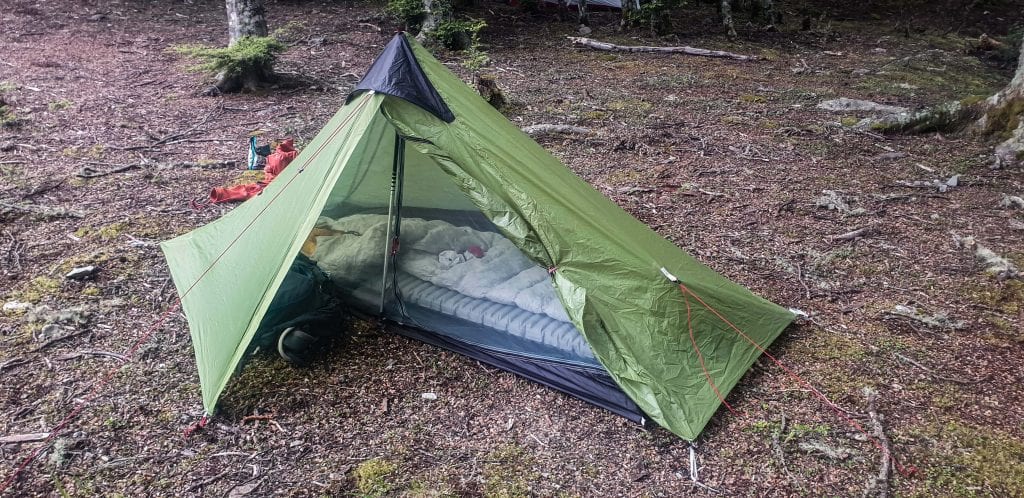
This uses one of my hiking poles as a support, is light and extremely packable – starting to get the picture of how I fit everything into a 30L bag?
Cooker
Cooking and food, now there’s a true tramping essential!
Tramping food selection is going to influence your choice of cooker. If you intend on cooking a roast or making pie then perhaps my choices won’t suit so well. When it comes to deciding on food to take tramping just think, what will go well with hot water? In the outdoors a lot of the time all you require is hot water.
The sheer arrangement of dehydrated food and ready meals should be on everyone’s list now. With dietary selections of vegan/vegetarian/gluten free and being tasty, paying the little bit extra for these is well worth it. Of course, cookers like the Jet Boil also have attachments too, so if you really want to cook that stew, you can.
I use my Jet Boil absolutely everywhere, from living in my van to even at work in the field when I fancy a brew. The fuel is inexpensive and light. Everything packs inside itself and is contained.
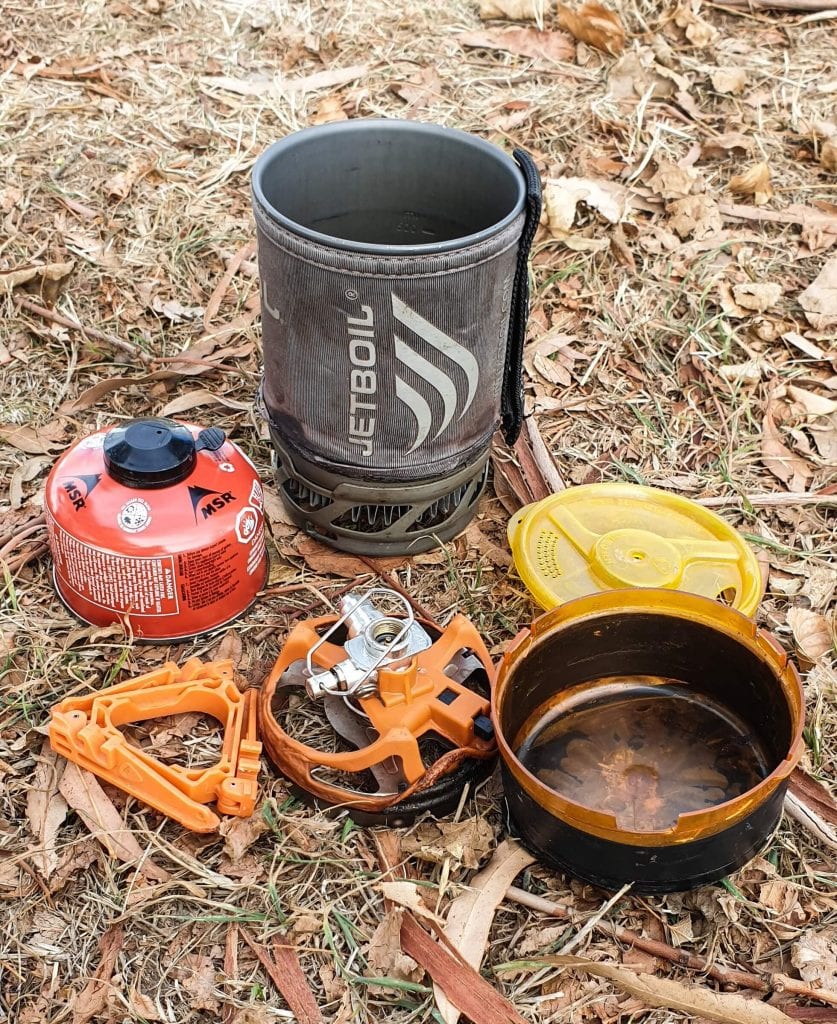
A more cost-efficient cooker is a simple gas attachment such as this camp stove from Bivouac, then all you need is a pot or pan.
My recommended favourites are the following;
Backpack
How about the term ‘backpacking’? you can’t get more self-explanatory than that right?? I love the humble backpack, of which I have many for all kinds of circumstances. Forget the days of heavy alloy framed packs! Today’s technology has gone leaps and bounds in this department, however if you go to your local REI, MEC, Macpac or what-be outdoors store, you’re likely to be overwhelmed.

Photo by Simon Migaj on
Unsplash
The following considerations will influence your choice of tramping bags;
- Gender
- Height
- Intended use
- Size of pack
When it comes to tramping packs, obviously you want one that fits. No one likes chafe or carrying a monkey on your back for hours. Find a good, snug, gender specific bag that fits you well, that has a good frame and is durable.
You can go all out with compartments these days, however, I find that one large compartment in the main, with side pockets, hip belt pockets and one large top pocket meets all my demands.
Compression straps are an asset, and you can change the load location and size of the bag – One Size almost fits all!
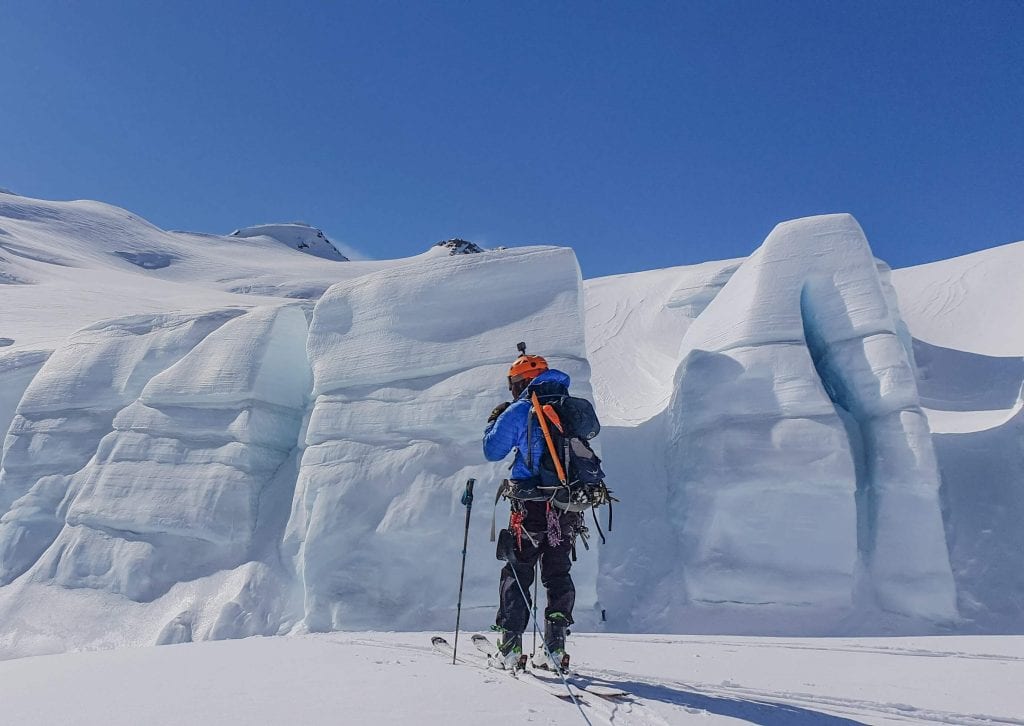
Size is closely related to your intended use. Are you doing day walks, or overnighters? Do you carry a lot of extras? What season are you going in? Going alpine? With all these considerations a 65L bag will be perfect for most larger adventures, or you can get away with a 45L if sensible and you pack light. For day walks a good 22-30L bag will solve all your world problems.
GRAB YOUR COPY OF LEE’S FREE HIKING GEAR CHECKLIST BELOW! IT WILL SAVE YOU SO MUCH TIME PACKING!
The form you have selected does not exist.
-The biggest bag I ever had was a 95L Tatonka (now that was a monkey on your back!). I had all my backpacking gear for summer/winter and paragliding gear inside… I was quite the sight in downtown New York!
What are the best tramping packs, NZ? As far as branding, I’m a firm believer in Osprey, Tatonka and Gregory. These overseas manufacturers make a huge selection of multi-use, light, durable and quality backpacks.
Check out the best hiking backpack brands below:
My partner in crime is the Gregory stout 45L. This pack has seen it all, from hiking, skiing, paragliding and climbing trips, and somehow has survived.
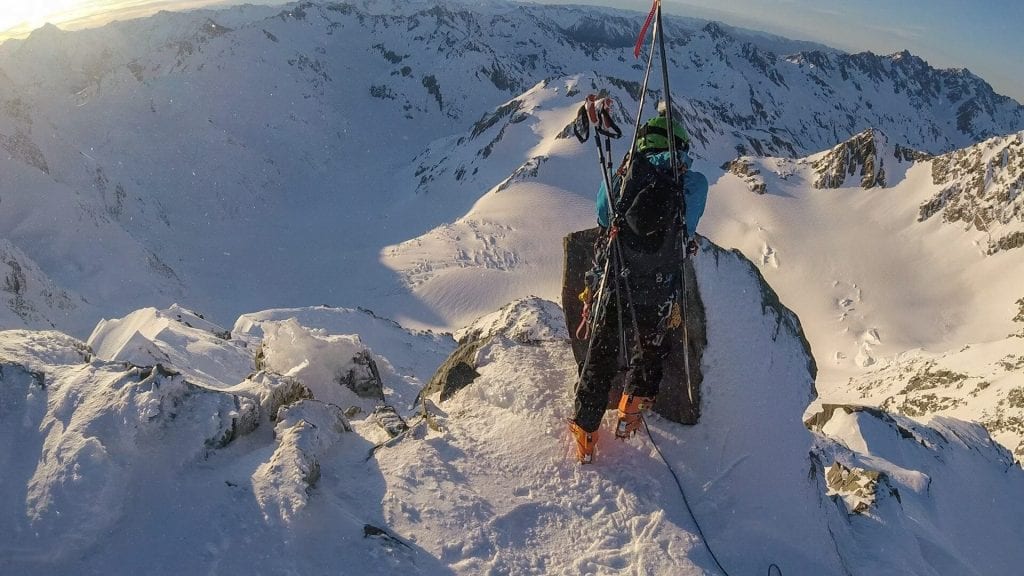
No doubt by now you’re all geared out, poor or both. I apologise in advance. Hopefully this has helped insight you on what to take tramping. Although my tramping gear recommendations are highly personal, I believe they are key essentials and I wouldn’t have gotten to or enjoyed as many adventures as I have without them.
I am finally at a stage where I can have my 5 tramping gear essentials packed into a 30L bag. I travel light and enjoy myself, much to the resentment of many passer-byers.
Of course, you don’t need all, or any of this tramping gear if you really have the enthusiasm to get outdoors. You would be amazed at how little you need to have a great time and experience what so many of us today miss out on, so roll up that foam mat, borrow that hand-me-down backpack and go cook your food on a fire, get out there and experience living, come back with photos, stories and memories. Just keep your underwear on.
Until next time,
Ev
Evan is a paraglider, backcountry skier, trail runner and mountaineer who seeks outdoor adventures at any opportunity he can get. If you’re keen to learn more from him you can contact him via his email address: evan.mckenzie@outlook.co.nz or Instagram @ev_mckenzie.
Loved this post? Pin the images below for later!
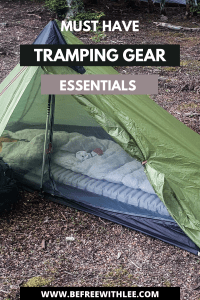
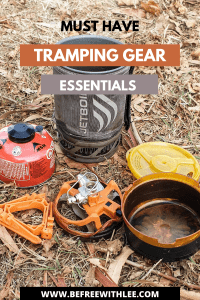
Other articles you might like:
Are hiking boots needed in NZ?
How to choose the right hiking shoes
This post contains affiliate links. If you purchase anything through them, I will get a small referral fee and you will be supporting me and my blog at no extra cost to you, so thank you!





Leave a Reply